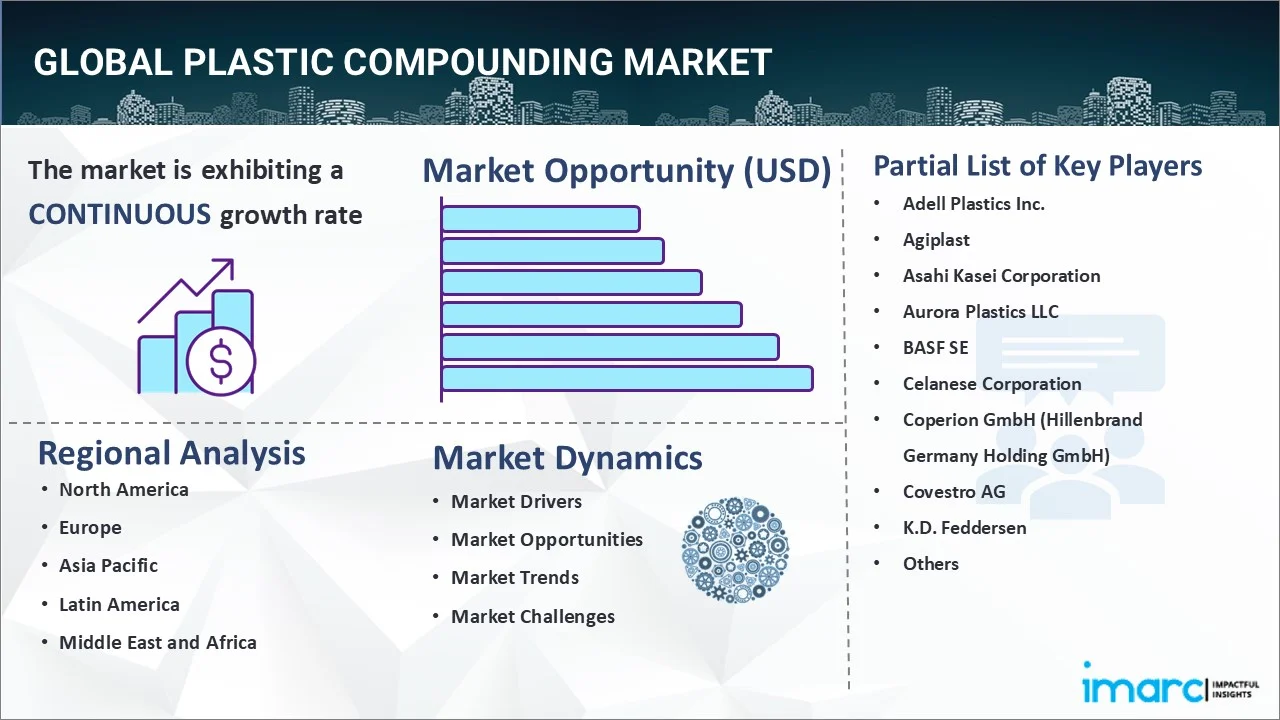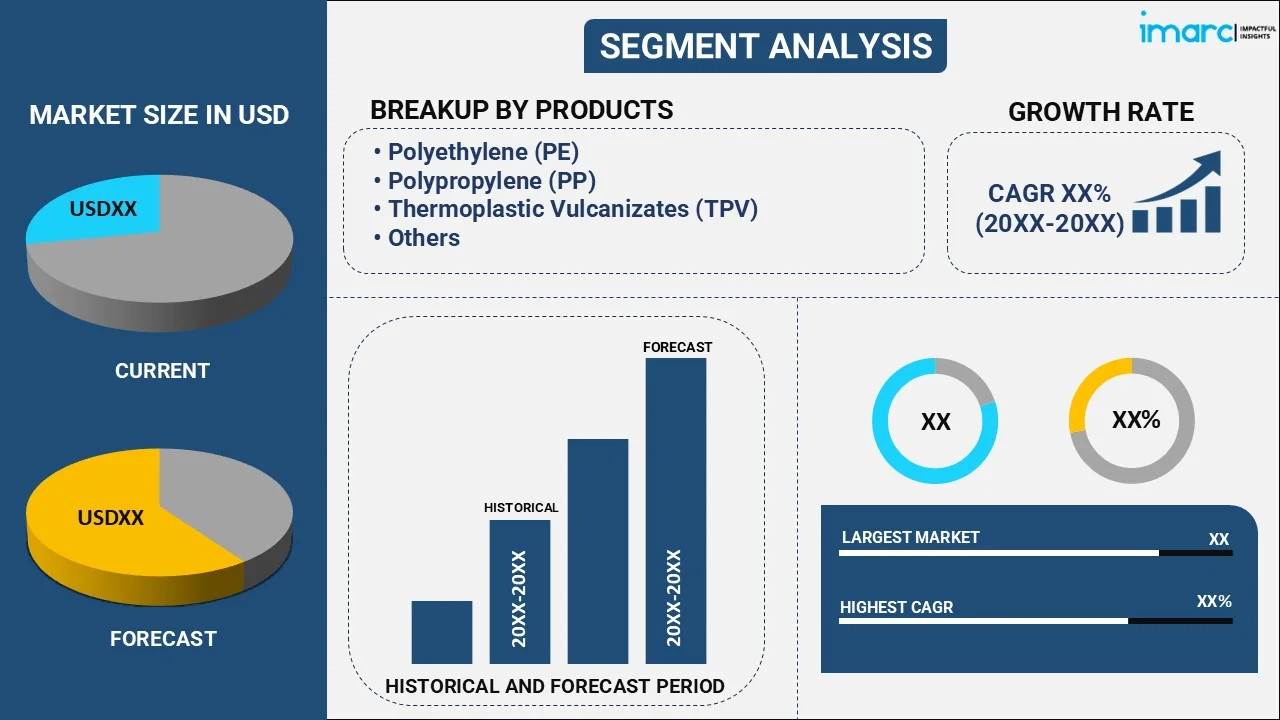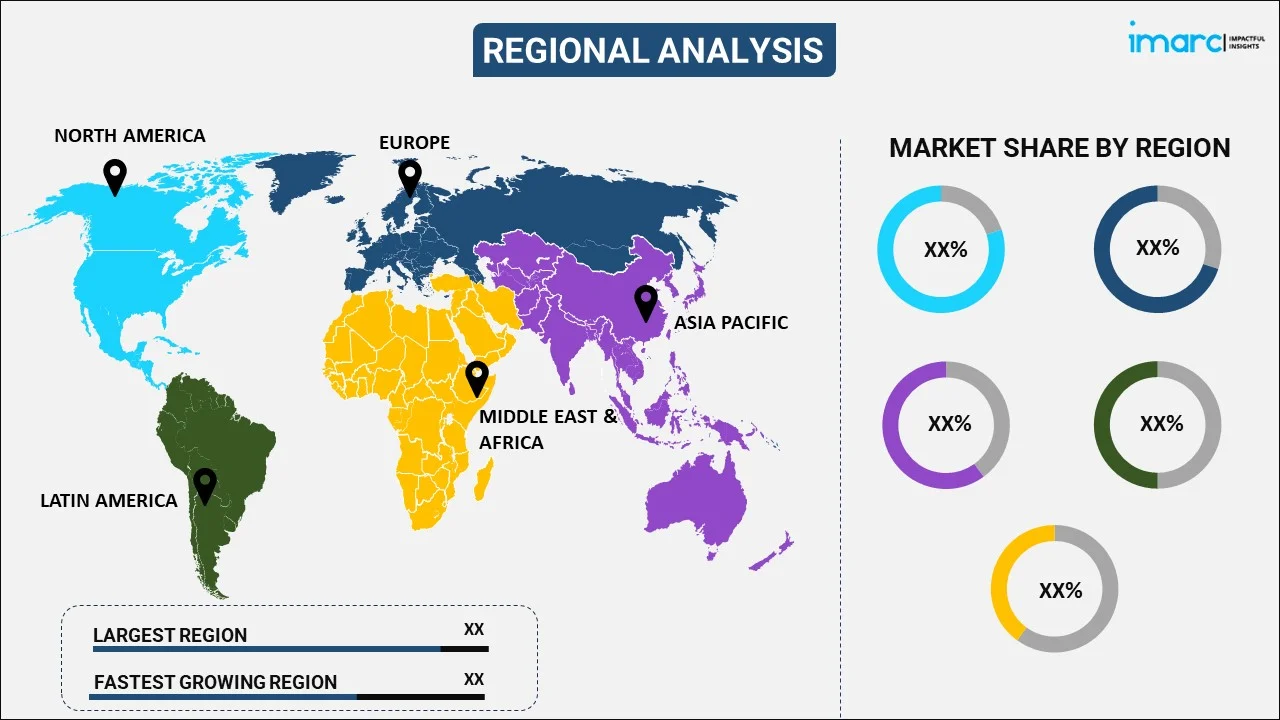
Plastic Compounding Market Report by Product (Polyethylene (PE), Polypropylene (PP), Thermoplastic Vulcanizates (TPV), Thermoplastic Polyolefins (TPO), Polyvinyl Chloride (PVC), Polystyrene (PS), Polyethylene Terephthalate (PET), Polybutylene Terephthalate (PBT), Polyamide (PA), Polycarbonate (PC), Acrylonitrile Butadiene Systems (ABS), and Others), Application (Automotive, Building and Construction, Electrical and Electronics, Packaging, Consumer Goods, Industrial Machinery, Medical Device, Optical Media, and Others), and Region 2025-2033
Market Overview:
The global plastic compounding market size reached USD 72.6 Billion in 2024. Looking forward, IMARC Group expects the market to reach USD 113.9 Billion by 2033, exhibiting a growth rate (CAGR) of 5.08% during 2025-2033. The escalating demand in the automotive sector for lightweight, durable materials that enhance fuel efficiency is driving the market growth. Moreover, the rise in construction and renovation activities across the globe, and continual technological advancements in polymer science represent some of the factors that are propelling the market demand.
|
Report Attribute
|
Key Statistics
|
|---|---|
|
Base Year
|
2024 |
|
Forecast Years
|
2025-2033 |
|
Historical Years
|
2019-2024
|
|
Market Size in 2024
|
USD 72.6 Billion |
|
Market Forecast in 2033
|
USD 113.9 Billion |
| Market Growth Rate (2025-2033) | 5.08% |
Plastic compounding refers to the process of blending plastics with additives, fillers, or reinforcements to achieve desired material characteristics that suit specific applications. During this procedure, base resins are intimately combined with elements such as flame retardants, antistatic agents, and plasticizers, among others, through various methods like blending, kneading, or melt-mixing. The outcome is a composite material possessing optimized mechanical, thermal, and electrical properties. These compounded plastics exhibit superior durability, resistance to environmental factors, and functionality compared to their base forms. By manipulating the additives, businesses can achieve a range of customizations, from increased tensile strength to enhanced coloration and improved flame resistance.

The global market is primarily driven by the escalating demand in the automotive sector for lightweight, durable materials that enhance fuel efficiency. Concurrently, a rise in construction and renovation activities across the globe is increasing the application of compounded plastics for critical components such as pipes and insulations. Alongside this, the healthcare industry's burgeoning need for specialized compounds for medical devices and sanitary applications is adding momentum to the market. Furthermore, the rapid expansion of e-commerce platforms necessitates durable packaging materials, further driving the plastic compounding market demand. Moreover, the globalization of supply chains across multiple sectors places an emphasis on consistent quality, thereby increasing reliance on compounded materials. Some of the other factors contributing to the market include the rising inclination toward versatile, aesthetically pleasing compounds in fashion industry, continual enhancements in compounding machinery, extensive research and development (R&D) activities focused on developing high-performance compounds, and stringent material requirements for extreme conditions in the aerospace industry.
Plastic Compounding Market Trends/Drivers:
Growing number of sustainability and circular economy initiatives
The growing emphasis on sustainability and the implementation of circular economy principles are shaping corporate strategies and consumer preferences alike. Regulatory bodies worldwide are increasingly setting stringent guidelines for the manufacturing sector, compelling companies to reduce their carbon footprint and minimize waste. In this context, compounded plastics that are designed to be recycled, reused, or biodegraded become immensely valuable. These products can be integrated into a closed-loop system, where materials are collected after their initial life cycle, reprocessed, and reintroduced into the manufacturing chain. This strategy is not only eco-friendly but also cost-effective in the long run. Moreover, the adoption of sustainable compounded plastics serves as a strong differentiating factor for companies, as it resonates with the values of a growing base of environmentally-conscious consumers.
Considerable rise in supply chain optimization
Supply chain optimization is another vital driver that is impacting the global market positively. Industries today are under constant pressure to operate more efficiently, necessitating a supply chain that is agile, responsive, and resilient. Compounded plastics are particularly advantageous in this scenario, given their wide array of customizable properties that can be tailored to specific industrial needs. By having a reliable, consistent supply of such specialized materials, companies can better plan their production schedules, minimize storage costs, and reduce waste. Furthermore, the globalization of supply chains requires adherence to international quality standards, making the consistent performance of compounded plastics even more critical. This drive towards supply chain optimization leads to closer collaborations between compounded plastic manufacturers and end-users, thereby creating a more streamlined and efficient system that significantly transforms the plastic compounding market outlook.
Continual technological advancements in polymer science
Breakthroughs in polymer science serve as a critical factor in the expansion of the market. With the integration of nanotechnology and computational simulations in material science, it's now possible to engineer compounded plastics with highly specialized properties. Innovations such as nanotechnology, computational simulations, and advanced polymerization techniques are enabling the creation of plastic compounds with extreme temperature resistance, high electrical conductivity, and unique optical characteristics. These advancements are allowing industries to replace metals, ceramics, and even some composite materials with compounded plastics, extending their use to high-end applications like aerospace, advanced medical devices, and renewable energy technologies. As a result, continual technological innovations in polymer science are not only fulfilling existing market demands but are also creating entirely new avenues and applications for compounded plastics market scope.
Plastic Compounding Industry Segmentation:
IMARC Group provides an analysis of the key trends in each segment of the market report, along with plastic compounding market forecast at the global, regional and country levels from 2025-2033. Our report has categorized the market based on product and application.
Breakup by Product:

- Polyethylene (PE)
- Polypropylene (PP)
- Thermoplastic Vulcanizates (TPV)
- Thermoplastic Polyolefins (TPO)
- Polyvinyl Chloride (PVC)
- Polystyrene (PS)
- Polyethylene Terephthalate (PET)
- Polybutylene Terephthalate (PBT)
- Polyamide (PA)
- Polycarbonate (PC)
- Acrylonitrile Butadiene Systems (ABS)
- Others
Polypropylene (PP) represents the largest market segment
The plastic compounding market research report has provided a detailed breakup and analysis of the market based on the product. This includes polyethylene (PE), polypropylene (PP), thermoplastic vulcanizates (TPV), thermoplastic polyolefins (TPO), polyvinyl chloride (PVC), polystyrene (PS), polyethylene terephthalate (PET), polybutylene terephthalate (PBT), polyamide (PA), polycarbonate (PC), acrylonitrile butadiene systems (ABS), and others. According to the report, polypropylene (PP) represented the largest segment.
Polypropylene (PP) represents a major segment in the plastic compounding market due to its diverse applications and cost-effectiveness. Its high resistance to chemicals, fatigue, and elasticity makes it suitable for automotive parts, consumer goods, and packaging solutions. Demand for lightweight materials in the automotive sector, coupled with the growing use of PP in reusable consumer goods, contributes to the market growth. In addition, advancements in catalyst technology have improved PP's mechanical properties, further driving its market demand. Regulatory norms advocating the use of recyclable materials are also supporting the growth of the PP segment.
On the other hand, polyethylene (PE), thermoplastic vulcanizates (TPV), thermoplastic polyolefins (TPO), polyvinyl chloride (PVC), polystyrene (PS), polyethylene terephthalate (PET), polybutylene terephthalate (PBT), polyamide (PA), polycarbonate (PC), acrylonitrile butadiene systems (ABS), and others are also experiencing a positive growth trajectory in the market. PE is heavily used in packaging, while TPV and TPO find applications in automotive interiors. Increased construction activity is driving the demand for PVC and PS, used commonly in pipes and insulation materials respectively.
Breakup by Application:
- Automotive
- Building & Construction
- Electrical & Electronics
- Packaging
- Consumer Goods
- Industrial Machinery
- Medical Device
- Optical Media
- Others
Automotive accounts for the majority of the market share
The report has provided a detailed breakup and analysis of the market based on the application. This includes automotive, building and construction, electrical and electronics, packaging, consumer goods, industrial machinery, medical device, optical media, and others. According to the report, automotive represented the largest segment.
In the automotive sector, the focus on lightweight materials to improve fuel efficiency has been a major market driver for plastic compounding. Advancements in plastics engineering have made compounds that can replace metal parts, offering the same strength but at a fraction of the weight. Regulatory pressures to lower carbon emissions and improve vehicle recyclability are leading to increased adoption of plastic compounds in automotive manufacturing. Manufacturers are also leaning towards bio-based and recyclable compounds to meet environmental norms. In turn, this sustains the growth of the automotive segment in the plastic compounding market.
On the other hand, building and construction benefit from plastics for insulation, while the medical device sector uses specialized plastic compounds for prosthetics and surgical tools. The packaging industry leans on plastic for its lightweight and durable properties, which also has positive implications for shipping costs. In the electrical and electronics sector, plastics are crucial for insulating wires and components.
Breakup by Region:

- North America
- United States
- Canada
- Asia-Pacific
- China
- Japan
- India
- South Korea
- Australia
- Indonesia
- Others
- Europe
- Germany
- France
- United Kingdom
- Italy
- Spain
- Russia
- Others
- Latin America
- Brazil
- Mexico
- Others
- Middle East and Africa
Asia Pacific exhibits a clear dominance, accounting for the largest plastic compounding market share
The report has also provided a comprehensive analysis of all the major regional markets, which include North America (the United States and Canada); Asia Pacific (China, Japan, India, South Korea, Australia, Indonesia, and others); Europe (Germany, France, the United Kingdom, Italy, Spain, Russia, and others); Latin America (Brazil, Mexico, and others); and the Middle East and Africa. According to the report, Asia Pacific accounted for the largest market share.
The Asia Pacific region is experiencing a considerable rise in the demand for plastic compounding due to rapid industrialization and increased manufacturing activities. The region's growing automotive sector is particularly beneficial for the plastic compounding market, as it's driving demand for high-performance materials. China, being the manufacturing hub, is significantly contributing to market growth, with its expanding industries in automotive, electronics, and construction.
Moreover, the region has been a focus for international companies looking to outsource manufacturing, thus increasing the local consumption of plastic compounds. The increased urbanization rates in countries like India and Southeast Asian nations further fuel the demand for plastics in construction and consumer goods.
In line with this, various governments in the region are setting regulations to promote the use of sustainable and recyclable materials, aligning with global environmental concerns. This regulatory landscape provides a constructive environment for innovative, eco-friendly plastic compounding solutions. Overall, the economic landscape, coupled with industrial growth and favorable policies, makes Asia Pacific a key market for plastic compounding.
Competitive Landscape:
Key players in the market are actively investing in research and development to create innovative, high-performance compounds. These market leaders are also focusing on strategic mergers and acquisitions to expand their product portfolios and reach new customer bases. To strengthen their market position, the major companies are forming partnerships with raw material suppliers, ensuring consistent quality and supply chain reliability. Furthermore, the prominent players are adopting sustainable practices by incorporating recycled or bio-based materials in their products to meet the growing environmental concerns. By engaging in vertical integration, some companies are gaining greater control over manufacturing processes, thereby reducing costs and enhancing product quality.
The report has provided a comprehensive analysis of the competitive landscape in the market. Detailed profiles of all major companies have also been provided. Some of the key players in the market include:
- Adell Plastics Inc.
- Agiplast
- Asahi Kasei Corporation
- Aurora Plastics LLC
- BASF SE
- Celanese Corporation
- Coperion GmbH (Hillenbrand Germany Holding GmbH)
- Covestro AG
- K.D. Feddersen
- LyondellBasell Industries Holdings B.V.
- Ravago Manufacturing India Pvt. Ltd.
- Solvay S.A
Recent Developments:
- In May 2021, Agiplast was acquired by Arkema. Agiplast specializes in the regeneration of high-performance polymers, and with this acquisition, Arkema will be the first fully integrated manufacturer of high-performance polymers offering both bio-based and recycled materials.
- In July 2023, Asahi Kasei Corporation announced that it has joined the Japan Hydrogen Forum (JH2F), which was established to support the decarbonization goals of U.S. federal, state, and local governments.
- In October 2022, Aurora Plastics LLC announced its merger with Enviroplas Inc. (“Enviroplas”), an engineering compounding business, in partnership with Enviroplas management. The move represents the company’s launch of an engineered polymers business segment.
Plastic Compounding Market Report Scope:
| Report Features | Details |
|---|---|
| Base Year of the Analysis | 2024 |
| Historical Period | 2019-2024 |
| Forecast Period | 2025-2033 |
| Units | Billion USD |
| Scope of the Report | Exploration of Historical and Forecast Trends, Industry Catalysts and Challenges, Segment-Wise Historical and Predictive Market Assessment:
|
| Products Covered | Polyethylene (PE), Polypropylene (PP), Thermoplastic Vulcanizates (TPV), Thermoplastic Polyolefins (TPO), Polyvinyl Chloride (PVC), Polystyrene (PS), Polyethylene Terephthalate (PET), Polybutylene Terephthalate (PBT), Polyamide (PA), Polycarbonate (PC), Acrylonitrile Butadiene Systems (ABS), Others |
| Applications Covered | Automotive, Building and Construction, Electrical and Electronics, Packaging, Consumer Goods, Industrial Machinery, Medical Device, Optical Media, Others |
| Regions Covered | Asia Pacific, Europe, North America, Latin America, Middle East and Africa |
| Countries Covered | United States, Canada, Germany, France, United Kingdom, Italy, Spain, Russia, China, Japan, India, South Korea, Australia, Indonesia, Brazil, Mexico |
| Companies Covered | Adell Plastics Inc., Agiplast, Asahi Kasei Corporation, Aurora Plastics LLC, BASF SE, Celanese Corporation, Coperion GmbH (Hillenbrand Germany Holding GmbH), Covestro AG, K.D. Feddersen, LyondellBasell Industries Holdings B.V., Ravago Manufacturing India Pvt. Ltd., Solvay S.A., etc. |
| Customization Scope | 10% Free Customization |
| Post-Sale Analyst Support | 10-12 Weeks |
| Delivery Format | PDF and Excel through Email (We can also provide the editable version of the report in PPT/Word format on special request) |
Key Benefits for Stakeholders:
- IMARC’s report offers a comprehensive quantitative analysis of various market segments, historical and current market trends, market forecasts, and dynamics of the plastic compounding market from 2019-2033.
- The research study provides the latest information on the market drivers, challenges, and opportunities in the global plastic compounding market.
- The study maps the leading, as well as the fastest-growing, regional markets. It further enables stakeholders to identify the key country-level markets within each region.
- Porter's five forces analysis assist stakeholders in assessing the impact of new entrants, competitive rivalry, supplier power, buyer power, and the threat of substitution. It helps stakeholders to analyze the level of competition within the plastic compounding industry and its attractiveness.
- Competitive landscape allows stakeholders to understand their competitive environment and provides an insight into the current positions of key players in the market.
Key Questions Answered in This Report
The global plastic compounding market was valued at USD 72.6 Billion in 2024.
We expect the global plastic compounding market to exhibit a CAGR of 5.08% during 2025-2033.
The rising demand for Electric Vehicles (EVs), along with the growing adoption of plastic compounding across the automotive industry to reduce the weight of automobiles by replacing heavy materials, such as metal and glass, is primarily driving the global plastic compounding market.
The sudden outbreak of the COVID-19 pandemic had led to the implementation of stringent lockdown regulations across several nations, resulting in the temporary closure of numerous end-use industries for plastic compounding.
Based on the product, the global plastic compounding market has been segmented into Polyethylene (PE), Polypropylene (PP), Thermoplastic Vulcanizates (TPV), Thermoplastic Polyolefins (TPO), Polyvinyl Chloride (PVC), Polystyrene (PS), Polyethylene Terephthalate (PET), Polybutylene Terephthalate (PBT), Polyamide (PA), Polycarbonate (PC), Acrylonitrile Butadiene Systems (ABS), and others. Among these, Polypropylene (PP) currently holds the majority of the total market share.
Based on the application, the global plastic compounding market can be divided into automotive, building & construction, electrical & electronics, packaging, consumer goods, industrial machinery, medical device, optical media, and others. Currently, the automotive industry exhibits a clear dominance in the market.
On a regional level, the market has been classified into North America, Asia-Pacific, Europe, Latin America, and Middle East and Africa, where Asia-Pacific currently dominates the global market.
Some of the major players in the global plastic compounding market include Adell Plastics Inc., Agiplast, Asahi Kasei Corporation, Aurora Plastics LLC, BASF SE, Celanese Corporation, Coperion GmbH (Hillenbrand Germany Holding GmbH), Covestro AG, K.D. Feddersen, LyondellBasell Industries Holdings B.V., Ravago Manufacturing India Pvt. Ltd., and Solvay S.A.
Need more help?
- Speak to our experienced analysts for insights on the current market scenarios.
- Include additional segments and countries to customize the report as per your requirement.
- Gain an unparalleled competitive advantage in your domain by understanding how to utilize the report and positively impacting your operations and revenue.
- For further assistance, please connect with our analysts.
 Inquire Before Buying
Inquire Before Buying
 Speak to an Analyst
Speak to an Analyst
 Request Brochure
Request Brochure
 Request Customization
Request Customization




.webp)




.webp)












